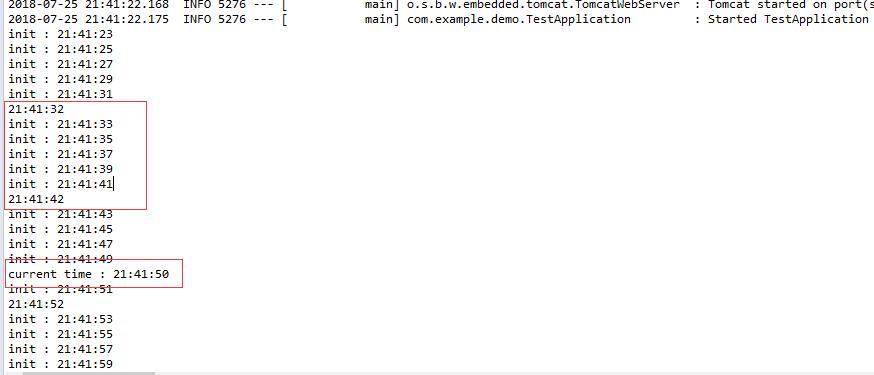SpringBoot之使用Scheduled做定时任务
定时任务有好多开源框架比如Quartz,@Scheduled是Spring的一个定时任务注解,通过注解配置就能够轻量级的定时任务,简单方便。
一、@Scheduled注解介绍
这里先贴上@Scheduled注解。然后下面的这几个属性的介绍。
* Copyright 2002-2018 the original author or authors. package org.springframework.scheduling.annotation; import java.lang.annotation.Documented;
import java.lang.annotation.ElementType;
import java.lang.annotation.Repeatable;
import java.lang.annotation.Retention;
import java.lang.annotation.RetentionPolicy;
import java.lang.annotation.Target; /**
* An annotation that marks a method to be scheduled. Exactly one of
* the {@link #cron()}, {@link #fixedDelay()}, or {@link #fixedRate()}
* attributes must be specified.
*
* <p>The annotated method must expect no arguments. It will typically have
* a {@code void} return type; if not, the returned value will be ignored
* when called through the scheduler.
*
* <p>Processing of {@code @Scheduled} annotations is performed by
* registering a {@link ScheduledAnnotationBeanPostProcessor}. This can be
* done manually or, more conveniently, through the {@code <task:annotation-driven/>}
* element or @{@link EnableScheduling} annotation.
*
* <p>This annotation may be used as a <em>meta-annotation</em> to create custom
* <em>composed annotations</em> with attribute overrides.
*
* @author Mark Fisher
* @author Dave Syer
* @author Chris Beams
* @since 3.0
* @see EnableScheduling
* @see ScheduledAnnotationBeanPostProcessor
* @see Schedules
*/
@Target({ElementType.METHOD, ElementType.ANNOTATION_TYPE})
@Retention(RetentionPolicy.RUNTIME)
@Documented
@Repeatable(Schedules.class)
public @interface Scheduled { /**
* A cron-like expression, extending the usual UN*X definition to include
* triggers on the second as well as minute, hour, day of month, month
* and day of week. e.g. {@code "0 * * * * MON-FRI"} means once per minute on
* weekdays (at the top of the minute - the 0th second).
* @return an expression that can be parsed to a cron schedule
* @see org.springframework.scheduling.support.CronSequenceGenerator
*/
String cron() default ""; /**
* A time zone for which the cron expression will be resolved. By default, this
* attribute is the empty String (i.e. the server's local time zone will be used).
* @return a zone id accepted by {@link java.util.TimeZone#getTimeZone(String)},
* or an empty String to indicate the server's default time zone
* @since 4.0
* @see org.springframework.scheduling.support.CronTrigger#CronTrigger(String, java.util.TimeZone)
* @see java.util.TimeZone
*/
String zone() default ""; /**
* Execute the annotated method with a fixed period in milliseconds between the
* end of the last invocation and the start of the next.
* @return the delay in milliseconds
*/
long fixedDelay() default -1; /**
* Execute the annotated method with a fixed period in milliseconds between the
* end of the last invocation and the start of the next.
* @return the delay in milliseconds as a String value, e.g. a placeholder
* or a {@link java.time.Duration#parse java.time.Duration} compliant value
* @since 3.2.2
*/
String fixedDelayString() default ""; /**
* Execute the annotated method with a fixed period in milliseconds between
* invocations.
* @return the period in milliseconds
*/
long fixedRate() default -1; /**
* Execute the annotated method with a fixed period in milliseconds between
* invocations.
* @return the period in milliseconds as a String value, e.g. a placeholder
* or a {@link java.time.Duration#parse java.time.Duration} compliant value
* @since 3.2.2
*/
String fixedRateString() default ""; /**
* Number of milliseconds to delay before the first execution of a
* {@link #fixedRate()} or {@link #fixedDelay()} task.
* @return the initial delay in milliseconds
* @since 3.2
*/
long initialDelay() default -1; /**
* Number of milliseconds to delay before the first execution of a
* {@link #fixedRate()} or {@link #fixedDelay()} task.
* @return the initial delay in milliseconds as a String value, e.g. a placeholder
* or a {@link java.time.Duration#parse java.time.Duration} compliant value
* @since 3.2.2
*/
String initialDelayString() default ""; }
cron属性
这是一个时间表达式,可以通过简单的配置就能完成各种时间的配置,我们通过CRON表达式几乎可以完成任意的时间搭配,它包含了六或七个域:
Seconds : 可出现", - * /"四个字符,有效范围为0-59的整数
Minutes : 可出现", - * /"四个字符,有效范围为0-59的整数
Hours : 可出现", - * /"四个字符,有效范围为0-23的整数
DayofMonth : 可出现", - * / ? L W C"八个字符,有效范围为0-31的整数
Month : 可出现", - * /"四个字符,有效范围为1-12的整数或JAN-DEc
DayofWeek : 可出现", - * / ? L C #"四个字符,有效范围为1-7的整数或SUN-SAT两个范围。1表示星期天,2表示星期一, 依次类推
Year : 可出现", - * /"四个字符,有效范围为1970-2099年
"0 0 12 * * ?" 每天中午十二点触发
"0 15 10 ? * *" 每天早上10:15触发
"0 15 10 * * ?" 每天早上10:15触发
"0 15 10 * * ? *" 每天早上10:15触发
"0 15 10 * * ? 2005" 2005年的每天早上10:15触发
"0 * 14 * * ?" 每天从下午2点开始到2点59分每分钟一次触发
"0 0/5 14 * * ?" 每天从下午2点开始到2:55分结束每5分钟一次触发
"0 0/5 14,18 * * ?" 每天的下午2点至2:55和6点至6点55分两个时间段内每5分钟一次触发
"0 0-5 14 * * ?" 每天14:00至14:05每分钟一次触发
"0 10,44 14 ? 3 WED" 三月的每周三的14:10和14:44触发
"0 15 10 ? * MON-FRI" 每个周一、周二、周三、周四、周五的10:15触发
fixedRate属性
上一个调用开始后再次调用的延时(不用等待上一次调用完成),这样就会存在重复执行的问题,所以不是建议使用,但数据量如果不大时在配置的间隔时间内可以执行完也是可以使用的。
fixedDelay属性
该属性的功效与上面的fixedRate则是相反的,配置了该属性后会等到方法执行完成后延迟配置的时间再次执行该方法。
initialDelay属性
该属性跟上面的fixedDelay、fixedRate有着密切的关系,为什么这么说呢?该属性的作用是第一次执行延迟时间,只是做延迟的设定,并不会控制其他逻辑,所以要配合fixedDelay或者fixedRate来使用。
二、@Scheduled注解实例
package com.example.demo; import java.text.SimpleDateFormat;
import java.util.Date; import org.springframework.scheduling.annotation.Scheduled;
import org.springframework.stereotype.Component; @Component
public class SchedulerTask {
SimpleDateFormat dateFormat = new SimpleDateFormat("HH:mm:ss"); @Scheduled(fixedRate = 10000)
public void timerRate() {
System.out.println(dateFormat.format(new Date()));
} //第一次延迟1秒执行,当执行完后2秒再执行
@Scheduled(initialDelay = 1000, fixedDelay = 2000)
public void timerInit() {
System.out.println("init : "+dateFormat.format(new Date()));
} //每天21点41分50秒执行
@Scheduled(cron = "50 41 21 * * ?")
public void timerCron() {
System.out.println("current time : "+ dateFormat.format(new Date()));
}
}
代码都使用了上了的@Scheduled属性。下图是执行打印的日志信息,timerInit方法是每隔2秒执行,timerCron设置在21点41分50秒执行,timerRate是每隔10秒执行。

三、添加@EnableScheduling注解
上面的定时任务并不能执行,还需要一步,需要设置开启定时任务,这个也很简单,只需在main方法上加上@EnableScheduling注解即可。
package com.example.demo; import org.springframework.boot.SpringApplication;
import org.springframework.boot.autoconfigure.SpringBootApplication;
import org.springframework.scheduling.annotation.EnableScheduling; @EnableScheduling
@SpringBootApplication
public class TestApplication { public static void main(String[] args) {
SpringApplication.run(TestApplication.class, args);
}
}
SpringBoot之使用Scheduled做定时任务的更多相关文章
- 定时任务-----Springboot中使用Scheduled做定时任务----http://www.cnblogs.com/lirenqing/p/6596557.html
Springboot中使用Scheduled做定时任务---http://www.cnblogs.com/lirenqing/p/6596557.html 已经验证的方案: pom文件加入依赖 < ...
- Springboot中使用Scheduled做定时任务
在开发中,定时任务是常见的功能,在spring boot 下开发定时任务其实很简单,具体代码如下: 1.配置依赖包pom.xml 由于默认的maven仓库经常访问不了,这里采用了阿里云的maven仓库 ...
- SpringBoot中使用@Scheduled创建定时任务
SpringBoot中使用@Scheduled创建定时任务 定时任务一般会在很多项目中都会用到,我们往往会间隔性的的去完成某些特定任务来减少服务器和数据库的压力.比较常见的就是金融服务系统推送回调,一 ...
- SpringBoot使用@Scheduled创建定时任务
定时任务一般会存在中大型企业级项目中,为了减少服务器.数据库的压力往往会采用时间段性的去完成某些业务逻辑.比较常见的就是金融服务系统推送回调,一般支付系统订单在没有收到成功的回调返回内容时会持续性的回 ...
- SpringBoot中使用task实现定时任务
定时任务实现的几种方式: Timer:这是java自带的java.util.Timer类,这个类允许你调度一个java.util.TimerTask任务.使用这种方式可以让你的程序按照某一个频度执行, ...
- spring的Scheduled(定时任务)和多线程
一.前言 在我们日常的开发中,经常用到数据同步的更新,这时我们采用的是spring的定时任务和java的多线程进行数据的更新,进行时实的服务调用. 二.实现思路 1.创建线程类 ...
- JFinal - scheduler 插件做定时任务
我在项目中遇到一个需求:服务运行期间,数据库要定期去监测某表并且更新. 正好项目是使用 jfinal 做的,于是就用了 jfinal-scheduler 插件来解决(jfinal-scheduler ...
- spring注解scheduled实现定时任务
只想说,spring注解scheduled实现定时任务使用真的非常简单. 一.配置spring.xml文件 1.在beans加入xmlns:task="http://www.springfr ...
- springboot+springmvc拦截器做登录拦截
springboot+springmvc拦截器做登录拦截 LoginInterceptor 实现 HandlerInterceptor 接口,自定义拦截器处理方法 LoginConfiguration ...
随机推荐
- Zookeeper系列2 原生API 以及核心特性watcher
原生API 增删改查询 public class ZkBaseTest { static final String CONNECT_ADDR = "192.168.0.120"; ...
- UVaLive 4064 Magnetic Train Tracks (极角排序)
题意:给定 n 个不三点共线的点,然后问你能组成多少锐角或者直角三角形. 析:可以反过来求,求有多少个钝角三角形,然后再用总的减去,直接求肯定会超时,但是可以枚举每个点,以该点为钝角的那个顶点,然后再 ...
- C++语言学习
1.< >表示包含那些由系统提供的并放在指定子目录中的头文件,对于自己编写的头文件放在当前目录或其他目录下则用双引号” ”; 2.复合类型的声明: int* p1,p2;//p1是指向in ...
- Winform嵌入CEF(非正常用法)
(一)复制下面必备文件|-- locales|--en-US.pak|--cef.pak|--cef_100_percent.pak |--cef_200_percent.pak|--cef_exte ...
- Python 装饰器(笔记,非原创)
定义:本质是函数,为其他函数添加附加功能原则:1.不能修改被装饰的函数的源代码 2.不能修改被装饰的函数的调用方式知识储备: 1.函数即“变量” 2.高阶函数 ...
- 玩玩vs Git 中国版 Gitee
下载vs 下载 Gitee.VisualStudio.vsix https://gitee.com/GitGroup/CodeCloud.VisualStudio/attach_files 去git ...
- Python环境搭建详解(Window平台)
前言 Python,是一种面向对象的解释型计算机程序设计语言,是纯粹的自由软件,Python语法简洁清晰,特色是强制用空白符作为语句缩进,具有丰富和强大的库,它常被称为胶水语言. Python是一种解 ...
- 兼容多数浏览器的js添加收藏夹脚本
浏览器不断发展,js的很多脚本需要跟进才能适应,目前多数代码对新版本浏览器(IE11, Firefox 27)无法适用,特关注跟进. 推荐代码1 适用浏览器:IE11(windows 8.1), Fi ...
- git关于文件权限修改引起的冲突及忽略文件权限的办法
我们在使用git进行版本管理的时候,有时候只是修改了文件的权限,比如将pack.php修改为777,但其实文件内容并没有改变,但是git会认为此文件做了修改,原因是git把文件权限也算作文件差异的一部 ...
- Python函数学习——匿名函数
匿名函数 匿名函数就是不需要显式的指定函数名. 关键字lambda表示匿名函数,冒号前面的n表示函数参数,可以有多个参数. 匿名函数有个限制,就是只能有一个表达式,不用写return,返回值就是该表达 ...
